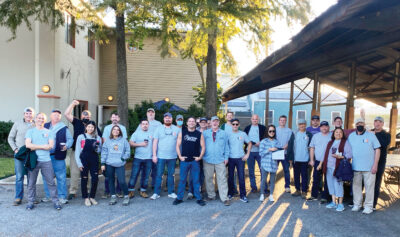Textured wood floors have been popular for several decades, and with good reason. Texturing wood achieves an aged look that often helps to hide minor scratches and dents. In some areas of the country, making wood floors look old is a lucrative skill to offer customers. Here are three popular texturing techniques.
Hand Scraping
Before sanding equipment was invented, wood floors were installed and scraped by hand. Scraping wood floors is a labor-intensive process that requires skill and artistry. Many factory-finished manufacturers use machinery to replicate the look of a hand-scraped floor, but scraping wood flooring by hand creates a one-of-a-kind floor.
Here are the common tools and techniques used to hand-scrape wood floors:
Blades
•Scraper blades are made using heavy-duty tempered metal.
•Blade shape dictates texture. Flat blades produce flat, smooth surfaces; curved blades produce gouges.
•Sculpted scraper blades can be shaped on a grinder.
•Once shaped, the blade must be hooked. The hook is formed using a smooth steel rod that is harder than the blade, and forcefully burnishing against the cutting edge of the blade at about a 90° angle.
•Once a blade is shaped and hooked, it must be sharpened using a mill/bastard file.
Mill/Bastard Files
•Pitch, pressure, and angle dictate how the blade is sharpened and how it cuts.
•Mill files are the most-common shape; they are rectangular in cross-section and taper slightly in width and thickness from tang to end. They are single-cut, meaning they have one set of teeth running parallel to each other.
•When the blade crosses a nail, it creates a burr in the blade which must be removed immediately to avoid leaving unsightly lines.
•If the blade begins sliding against the surface, it must be sharpened.
Handles
•Scraper handles can be made using many materials. Wood and metal are most-common.
•Handle grip and length are important, as is comfortable finger placement.
•When scraping, place the front hand on the area above the blade using a downward pressure. The back hand grips the handle and pulls toward the user.
Other Scraping Tools
•Hand or block planes work well to scrape material from the surface, but are less effective. The blades can be modified to be more aggressive. Planes usually are pushed rather than pulled, which creates different textures.
•Spoke-shave scrapers use a similar blade, with handles on either side. These are similar to draw knives.
•Paint scrapers work well and can be modified to be more or less aggressive.
•Chisels can work to give a “scraped” appearance.
Scraping Process
•Bench scraping
-Flooring can be placed on a bench to scrape from a standing position.
-The bench must have a stop to secure the flooring.
-This process allows the flooring to be prescraped before being installed. The benefit of prescraping is the ability to define all four edges because the sides and butts of each piece can be accessed.
•Floor scraping
Scraping an installed floor is considered traditional floor scraping.
The benefit of this process is customizing the flooring in place.
•Never sharpen the scraper on the flooring surface. The metal shavings can oxidize and create rust spots after applying finish.
•Knots, burls, or other natural characteristics will scrape harder than regular grain patterns.
•Softer species scrape easily; harder species are more difficult to scrape.
•Everyone scrapes with a different angle, pressure, and idea of how the scraped floor should look. When scraping with more than one person, be sure to move them around to achieve a random texture.
•Different effects
-Scraper blade angle will determine the material removal rate.
-Cross-grain scrape for a torn-grain appearance.
-Chatter the scraper to achieve a chattered appearance.
-Highlight the edges of boards with the scraper blade.
-Once the entire floor is completed, lightly abrade the surface by hand or with a hand-held random orbital or a buffer/swing machine using a thick pad and finer grit abrasive to smooth out the rough surfaces.
Wire Brushing
Wire brushing removes the soft grain from the wood flooring surface, producing a weather-worn appearance.
Wire brushing can be achieved on an existing wood floor with the proper tools. Hand-held wire brushes or grinder wheels with a wire brush attachment can be aggressive enough to remove soft material from the flooring surface, but on larger jobs this can be slow, tedious work. Most wire brushed floors are given this effect prior to installation by use of automated machines specifically designed to produce the brushed effect.
Distressing
Distressing a wood floor can include many different characteristics:
•Creating indentations and gouges in the flooring surface.
•Creating texture on the wood floor with scrapers, sanders, or grinders.
•Using heavy chains, hammers, and chisels to create dents and cracks on the wood.
•Using drills and ice picks to create worm-hole effects.
•Using soldering irons, propane torches, or hot sand to add burn-mark effects.
•Using saws to create saw-mark effects.
•After the distressing is complete, many contractors accentuate it by adding black wood filler, resin, acid inks, or dyes. Applying dark stain traps the color in the nooks and crannies of the floor.
•Experiment on test samples and acquire client approval and signatures before proceeding.
The National Wood Flooring Association has detailed information about textured wood floors available through NWFA University, an online training platform that is convenient and affordable. More information is available at nwfa.org









